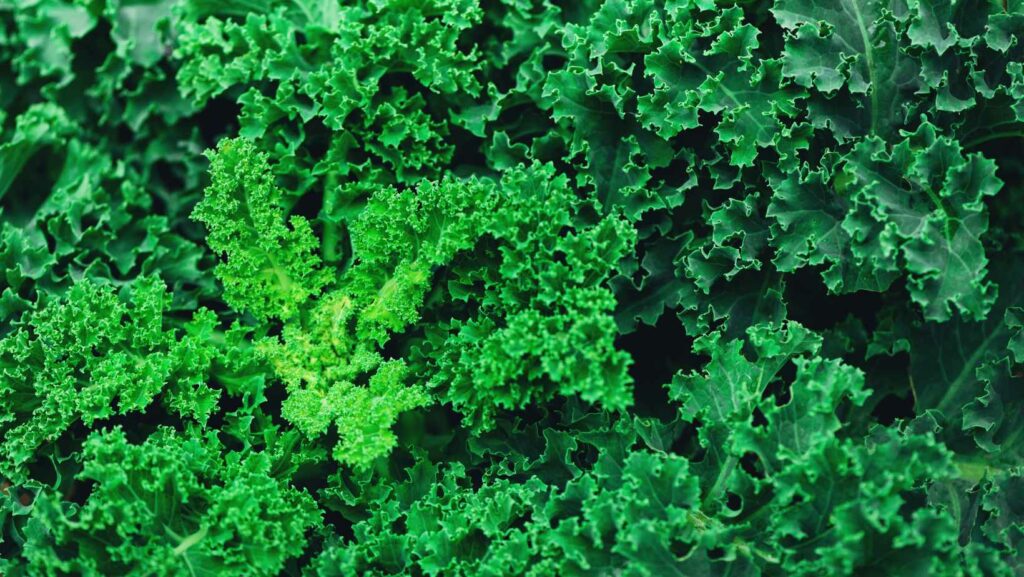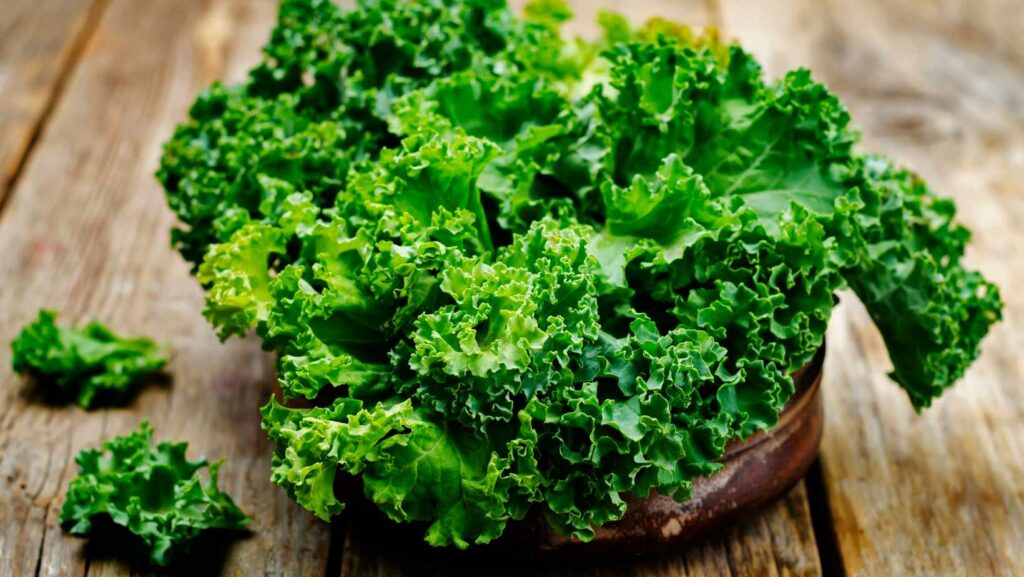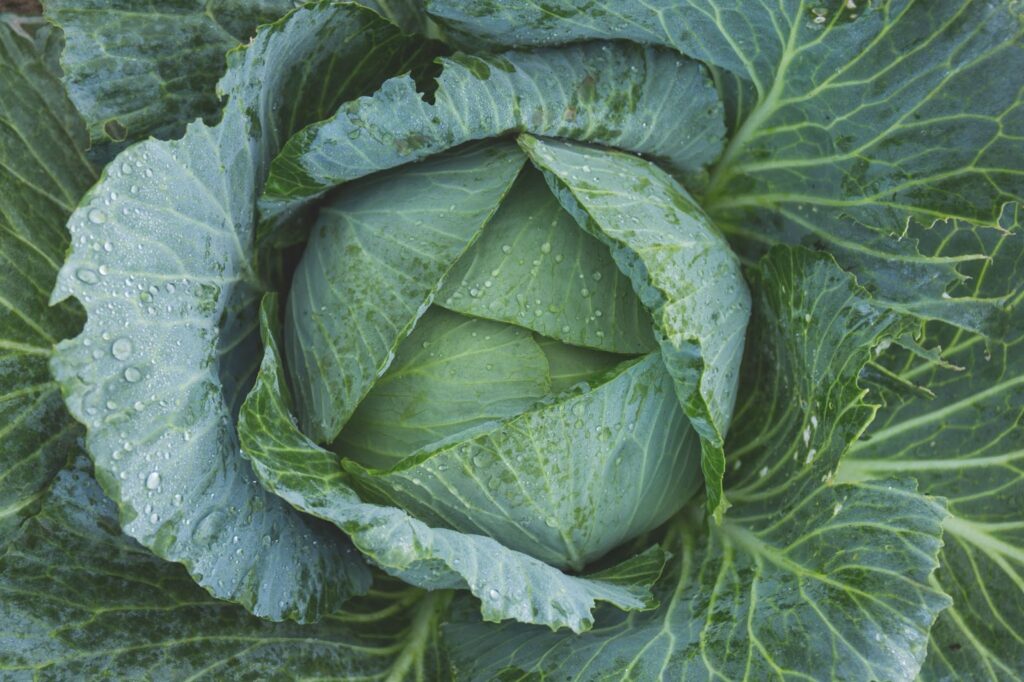In order to effectively chop kale, there are several important tools that can greatly enhance your efficiency and precision. These items will allow you to prepare the kale leaves in various ways, including cooking, juicing or using in salads. Here’s what you need for a perfect kale preparation:
- A sharp chef’s knife with a comfortable handle
- A cutting board that is sufficiently stable and big enough for your needs
- A pair of sturdy kitchen scissors or shears to remove the tough stems and other unwanted parts of the leaves
- A salad spinner or strainer colander – both are great for washing and drying the kale leaves after cutting.
- Bessler Food Processor – this easy-to-use gadget is perfect for saving time by quickly chopping kale into small pieces with its multipurpose metal blade.
- Gloves made from food-safe silicone or rubber because kale can sometimes be sticky when working with it.
Moreover, to get an even cleaner cut on each leaf, it’s essential to make sure that your knife is sharpened frequently.
If you’re looking for an interesting fact about this green vegetable, here it is. Did you know that kale has been grown in Greece since ancient times? While it may have been overlooked by many cultures throughout history as mere fodder for livestock, today it stands out as one of the most highly valued greens worldwide. So go ahead and grab these essential tools mentioned above and bring out the best in every kale recipe!
Let’s face it, preparing kale is like getting ready for a blind date – it’s all about first impressions.
Preparing Kale for Chopping
To prepare kale for chopping in a better way, follow these simple solutions with the sub-sections – Removing the Stems and Washing and Drying. These tips will help you get the most nutrition and the best texture out of your kale.
Removing the Stems
When it comes to the preparation of kale, eliminating its tough and fibrous stems is an essential step for optimal flavor and texture. Here’s how to go about it:
- Start by holding the kale leaves firmly with one hand while using your other hand to pull down on the stem towards the base of the leaf.
- Use a sharp knife to cut along either side of each stem if some parts still resist removal.
- Once all the stems have been removed from a set of leaves, discard them or save them for use as a hearty addition to stocks or soups.
- Rinse the leaves thoroughly under cool running water, shaking off any excess moisture quickly afterward.
- Dry or towel off excess moisture to get an even drier result.
- The kale is now ready and can be chopped according to preference.
It’s worth noting that the toughness of kale stems varies depending upon their maturity level. Younger stems may require little more than a gentle nudge, while older ones may need more targeted force. Regardless of their age, however, always make sure you’re pulling in a smooth motion with as little effort as possible.
When removing stems from kale, always aim for long strokes instead of smaller pieces at each end. This technique allows you to work much faster while keeping your kitchen clean.
From my personal experience trying out different techniques and utensils when removing kale stems, I found vegetable peelers very effective in catching onto stubborn strands and helpfully agitating them away without damage or waste. Who knew washing and drying kale could make you feel like a plant parent giving their baby a bath?
Washing and Drying

Properly Sanitizing and Dehydrating
To prepare kale for chopping, it is essential to sanitize the leaves thoroughly. Ensure that you’re using clean water and your hands to rinse every leaf correctly.
Fill a sink with cool water and immerse the kale in it. Gently agitate the leaves to remove any dirt or debris. Drain the sink and refill with cold water, but this time add about one tablespoon of salt per quart of water. Soak kale in saltwater solution for around five minutes.
Remove the kale from the sink without draining out the salty water. Then dry your kale completely by gently shaking off excess liquid, patting down with a clean towel or running through a salad spinner.
Preferably after drying, place on baking sheets in single layers, oven set at low temperatures or food dehydrator- for preservation.
Additionally, it’s important to note that if you are using pre-washed packaged kale, there would be no need for saltwater soaking.
True Story
I once made a salad consisting of chopped kale leaves that had not been properly sanitized. Unfortunately, this resulted in stomach cramps which were triggered by consuming these greens uncleaned. It was indeed an unforgettable experience as well as an important lesson learned – always sanitize before chopping!
Chopping kale is like a karate workout for your knife skills.
How to Chop Kale

- Step 1: Washing
- Step 2: Drying
- To master the art of chopping kale with ease, use the rolling and chopping technique or crosswise chop technique provided in this section on ‘How to Chop Kale’. These two sub-sections offer solutions that can make the process more efficient and less time-consuming. So, let’s get started with your kale-chopping journey!
Rolling and Chopping Technique
Kale can be intimidating, but with the right technique, it’s easy to chop. Follow these steps for a perfect roll and chop every time.- Wash your kale thoroughly and remove any tough stalks or large stems.
- Lay your leaves out on a flat surface and fold them in half lengthwise so that the stem is on one side.
- Starting at the end where the stem is located, tightly roll the kale into a tube shape.
- Use your sharpest knife to slice across the tube into thin ribbons – they should soften up as you go.
- Finally, give your kale ribbons another rough chop to ensure they’re evenly sized, then add them to your recipe.
- For optimum results, use fresh organic kale and keep in mind that chopping kale too finely can cause it to become bitter. Stay aware of these techniques for an optimal taste experience.
Fun fact: Did you know that kale has more iron per calorie than beef? (Source: Healthline)
Chopping kale crosswise may seem violent, but trust me, this veggie has it coming.
Crosswise Chop Technique
When it comes to preparing kale, a commonly utilized method is chopping. The technique referred to as cutting across the width of the leaves is a crucial component in achieving evenly sized pieces.
Here is a six-step guide that will assist you in mastering the ‘Side-to-Side Chop Method.’- Begin by washing the kale leaves, then pat them dry to remove any excess water.
- Remove the stems from each leaf using either your hands or a knife, keeping only the leafy greens.
- Pile several leaves on top of one another, aligning them evenly while holding them securely with one hand.
- Slice through the greens using side-to-side motions with your free hand and a sharp knife until they are appropriately chopped.
- Reposition each pile back into place and start again until every piece has been chopped.
- If you want smaller pieces of kale, repeat this process several times until you achieve your desired size.
- It’s essential to note that professionals recommend utilizing a large cutting board so that when chopping, there’s enough room for each bunch. Moreover, sharpening knives before every use can result in better outcomes.
Pro Tip: For boosting efficiency, some suggest using kitchen shears instead of straight chop method.
Slice and dice your way to a pile of perfectly chopped kale with these efficient tips.
Tips for Chopping Kale Efficiently
To chop kale efficiently with ease, sharpen your knife and group and chop similar-sized kale leaves together. In this section of more tips for chopping kale, you’ll find solutions that can be helpful if you are struggling with the process. The sub-sections, sharpening your knife and grouping the kale leaves, will make your chopping process efficient and hassle-free.
Sharpening Your Knife
Having a sharp knife is paramount for efficient chopping of kale. A blunt knife can crush the leaves, making it messy and time-consuming. Here’s how to hone the blade of your knife.- Hold the knife firmly with one hand while holding a sharpening stone securely with the other.
- Gently place the sharpening stone at a 20-degree angle against the blade’s edge.
- Drag the stone along the entire length of the blade, starting from its base to its top.
- Repeat steps two and three on either side of the blade until you achieve desired sharpness.
- To ensure safety, always keep fingers clear. Additionally, use honing steel regularly to maintain knife sharpness.
A finely-sharpened knife not only simplifies chopping kale but also improves kitchen safety. Practice these simple techniques daily and be amazed by how kale-chopping will never be challenging anymore.
Interestingly, evidence suggests that people have been using knives since as early as 2 and half million years ago. The first knives were made from rocks and used for hunting or carving wood. Knife technology has come a long way since then, from metal blades to ceramic ones. As for sharpening, nowadays we have electric sharpeners too!
Let’s face it, no one enjoys a kaleidoscope of different-sized kale pieces in their salad. Group and conquer with this leafy green hack.
Grouping and Chopping Similar-Sized Leaves Together
To optimize your time when chopping kale, sorting and cutting leaves of similar sizes together is key. This ensures that every piece is cut consistently and prevents uneven cooking or preparation.
Here’s a six-step guide to efficiently grouping and chopping similar-sized kale leaves:- Start by washing your kale leaves and patting them dry with a clean towel.
- After that, remove the tough stems from each leaf, carefully cutting close to the stem so as not to waste any of the green parts.
- Gather leaves of similar sizes into manageable bunches.
- Hold your knife perpendicular to the edge of the leafy part and start chopping raw kale into thin slices.
- If you prefer chopped pieces instead, dice each bunch into small squares or roughly chop them into smaller pieces.
- Transfer all cut-up pieces of kale into a large bowl.
- Another tip for efficient kale preparation is using high-quality sharp knives. It ensures smooth cuts while reducing workload strains on your hand muscles.
Lastly, a friend once shared that her experience in mastering this technique was life-saving for her during rushed weeknights. She could hustle through tons of leafs at once so she could enjoy some downtime.
With these tips at hand, experiment away with the way you slice your next batch and savor every bite! Store your chopped kale in an airtight container and you’ll feel like a real-life Popeye every time you open the fridge.
Storing Chopped Kale
To easily store your chopped kale with minimal wastage, this section on ‘Storing Chopped Kale’ with sub-sections ‘Refrigerating Chopped Kale’ and ‘Freezing Chopped Kale’ is here to help you. Keep reading to find out the best ways to store your chopped kale, so you can keep it fresh and flavorful for as long as possible.
Refrigerating Chopped Kale
The Proper Way to Refrigerate Chopped Kale
Keep your kale leaves fresh with this six-step guide on refrigerating chopped kale:- First, wash the kale thoroughly and pat it dry.
- Then, remove the stem and chop the leaves.
- Place them in a large bowl or container.
- Cover the bowl or container with a lid or plastic wrap.
- Store it in the refrigerator’s crisper drawer.
- Check and discard any brown or wilted pieces daily.
- It is noteworthy that you can store chopped kale for up to 5 days in an airtight container before cooking or eating it as a salad.
Did you know that kale is an excellent source of Vitamins A, K and C? (Source: Medical News Today)
Say goodbye to your freezer burn woes with this kale-arious solution for freezing chopped kale.
Freezing Chopped Kale
To properly store and preserve chopped kale for future use, consider freezing it. This is an effective way to ensure that the nutritional value and freshness of the kale remain intact.
Here is a simple 3-step guide to follow when freezing chopped kale:- Clean the kale thoroughly by removing any dirt or unwanted material. Rinse it carefully in cold water.
- Blanch the kale by boiling it quickly in hot water. Ensure that it is fully submerged before removing it after 2-3 minutes.
- Rinse the blanched kale again in cold water and pat dry before storing in freezer-safe bags or containers.
- It’s important to note that frozen chopped kale can last for up to six months when stored properly. To thaw frozen chopped kale, simply move it from your freezer into your refrigerator and wait for a few hours.
In addition, consider labeling all stored bags or containers with the date of freezing to keep track of their freshness.
Don’t let your fresh kale go bad! Freeze today and enjoy later without fear of missing out on great nutrition.
Kale yeah, these recipe ideas will have you chopping for joy!
Recipe Ideas for Chopped Kale
To discover exciting recipe ideas for chopped kale with the ‘More Tips for Chopping Kale’ article and save your time, you will find two fantastic recipe ideas for kale salad and sautéed kale with garlic and lemon juice.
Kale Salad with Lemon Dressing
For a refreshing twist to your meal, try this zesty citrus kale salad.- A basic recipe for Kale Salad with Lemon Dressing includes massaged kale leaves, almonds, and lemon dressing topped with grated parmesan cheese.
- It is quite simple to make and requires minimal preparation time.
- The zesty flavors are thanks to the combination of fresh lemon juice and olive oil in the dressing.
- This salad has numerous health benefits, including help with digestion and a boost in energy levels, thanks to kale’s high vitamin content.
- To add more flavor, consider incorporating other ingredients such as dried cranberries or grilled chicken.
For an elegant twist to Kale Salad with Lemon Dressing, consider topping it off with pomegranate arils or crumbled feta cheese for a nice blend of tangy textures.
Garlic and lemon juice make everything taste better, including chopped kale – the most underappreciated member of the salad family.
Sautéed Kale with Garlic and Lemon Juice
This dish is a recipe for sautéed kale that imparts a perfect taste of lemon and garlic. It is a simple yet delicious recipe that shall leave your taste buds asking for more.- Start by washing the kale leaves properly and spin them dry.
- Heat olive oil in a pan on medium heat, add garlic cloves till they are golden brown and fragrance set in.
- Add kale leaves to the pan with salt, tastefully stirred until wilted.
- Squeeze some fresh lemon juice from half of a lemon onto the kale leaves. Drizzle it with black pepper shortly before turning off the flame.
- Mix everything well, and serve hot as an excellent side dish with any meal.
- Unlike other recipes, this one only requires 4-5 minutes of cooking time. Plus, you can add pine nuts or parmesan cheese to give it an extra flavor boost.
Pro Tip: Use curly leaf kale variety as they have tender stems making them easier to cook compared others.
